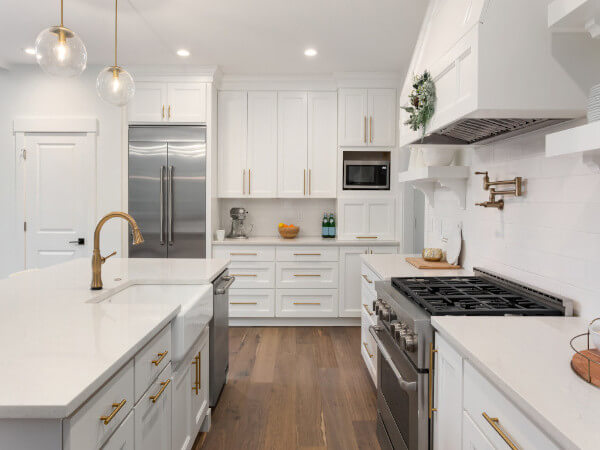
Examining the Origins of Creativity
Have you ever been asked, “Where did you get that idea?”
Have you ever wondered what creativity is, and where ideas come from? I have – all my adult life. While there are many answers, I think a great one is, “It’s a gift to be shared.”
What I’m talking about specifically here are unique solutions that solve problems, like storage needs and designing for function and safety. Combine these challenges with the homeowner’s desire for a unique appearance that fits their lifestyle, and the result? We have the makings of an award-winning kitchen or bathroom.
Design award applications usually require a summary of how we solved the project owner’s problems, and the recap makes before-and-after photos more relevant. If our entries offer original solutions, they deserve praise. The recognition boosts our confidence.
THE ORIGINS
Where does creativity originate? You’re taking a shower, and an idea flashes out of nowhere. You think to yourself, “What if I…?” You can’t wait to test the reality of your idea on your clients’ plans. From that idea comes another one, and another one. It’s like someone unlocked the vault of ingenious results for you. You’re motivated.
Albert Einstein said, “Creativity is intelligence having fun.” He had intimate knowledge of the universe, and he understood visionary imagination.
As kitchen-bath design specialists, we have a collection of skills and information acquired through our experience. Our intelligence allows us to apply the knowledge to solve problems. But, it’s more than that. Creativity frees our minds to absorb knowledge. It enables alternative ways of thinking.
How do you feel when you discover a spectacular new product at the Kitchen & Bath Industry Show, or in a Kitchen & Bath Design News article? There’s a tingle of excitement, and you can’t wait to solve homeowners’ problems with it. Creativity unblocks our old patterns of thinking. As a result, we’re more receptive to new ideas.
I’ve experienced good luck with product information that got tucked in the “future use file” of my mind. For example, I recommended a Duravit all-glass pedestal lavatory to a new client six months after I learned about it. She still loves it!
And I remember the drop-dead gorgeous Vetrazzo “Sky” countertop that wowed clients when I created a new laundry room for them – two years after discovering Vetrazzo for a blog. Then there was the joy I felt recently, saving a client over $3,000 by substituting bronze plumbing fittings I’d seen in an online newsletter last year.
These experiences are not uncommon for us.
Creativity is fun. We lose track of time when we’re engrossed in creating plans for a client or researching the right products that will make their hearts sing. Getting into a “zone” is like meditating. Experts agree that this helps us live longer. Somehow, we find a way to balance our desire to innovate and perform boring – but necessary – tasks.
Creative ideas are everywhere, always available to us when we need or want to improve our world. One way to explain it is finding a need and then creating a solution. Creativity helps draw out what is already there waiting to be used so that possibilities can emerge. Albert Einstein understood this concept and taught it passionately.
Early in my career, I had a client who wanted to store two sets of eating utensils in her small condominium kitchen with space for only five drawers. I designed a drawer within a drawer, instructing the cabinetmaker to lower the drawer back and then install full-extension glides backward on the top section so it slid back. About six months later, Rev-A-Shelf introduced the same solution for the mass market. So, I was solving an individual need at the same time that Rev-a-Shelf was solving a popular need.
BUILDING CONNECTIONS
Creativity builds intercultural and intergenerational connections.
This is shown by the worldwide acclaim of America’s architectural genius, Frank Lloyd Wright. He died in 1959, at 91. Yet his work still inspires architects and designers 62 years later. Wright was the first architect in history to use cantilevering in his famous Mill Run, Pennsylvania home. He designed “Fallingwater” for Edgar Kaufman in 1935. Evidence of his continuing popularity? Architects and designers are recreating Wright’s “Prairie-style” homes for today’s homeowners.
I love one of the stories about Wright – and there are thousands! He had very little income from his architecture practice for about 12 years (1922–1934). But he kept drawing plans and renderings for residences and public buildings. He also created graphic art for postcards. And he was a prolific writer. Hundreds of his articles appeared in House Beautiful and other popular magazines during that period. His self-promotion paid off. Clients began hiring him in 1934 after they recovered from the depression. He never looked back, proving that creativity is nurturing. Wright had more successful commissions in the last 30 years of his life than he had in the first 61 years!
Like Wright and other well-known innovators, today’s designers will impact future designers. They will inspire and motivate everyone to achieve their own success. We see this in our profession now. Many peers earn honors for their work because they are fearless in their creative expression. Their work will pass the test of time. They are not bound to what’s popular now because they are thinking ahead to the future. They have curiosity and open minds to play the “What if?” game. They often win.
But we see only the wins, not the losses. Creative people have a great habit of learning from every experience. They’re driven to improve themselves and everything around them.
I became aware of this when I taught Western design to Japanese interior design students in San Francisco and gave them a special assignment. They had to create a large master bathroom in a 17’x17′ area. Naturally, they were eager to learn and use the new skills they’d acquired. Not accustomed to large bathrooms, the students had fun uncorking their creativity.
There was one student, Izumi, who lit up the room with her enthusiastic ideas and questions. When it was time to review her plan one-on-one, she was trembling, afraid that I would criticize her work. Her plan wasn’t to scale. But her design was unique and it earned my praise for achieving something radically different. She designed a round bathroom with many windows surrounding a center closet! We joyfully worked together after class, figuring how to make her idea possible.
Like Izumi’s bathroom, I’ve come full circle – back to where I started, with the same question: What is creativity, and where does it come from? The conclusion: Creativity, like love, is an unlimited feeling, indefinable.
No, creativity is love. 
Diane Plesset, CMKBD, CAPS, NCIDQ is the principal of D.P. Design in Oregon City, OR and has over 35 years of experience as a kitchen and bath designer. She is the author of the award-winning book, THE Survival Guide: Home Remodeling, and has been the recipient of numerous design awards. Named a 2019 KBDN Innovator, Plesset has taught Western design to students of the Machida Academy in Japan and has a podcast, “Today’s Home.”
The post Examining the Origins of Creativity appeared first on Kitchen & Bath Design News.
Did you miss our previous article…
https://www.stuffedgourmetpretzels.com/?p=831




